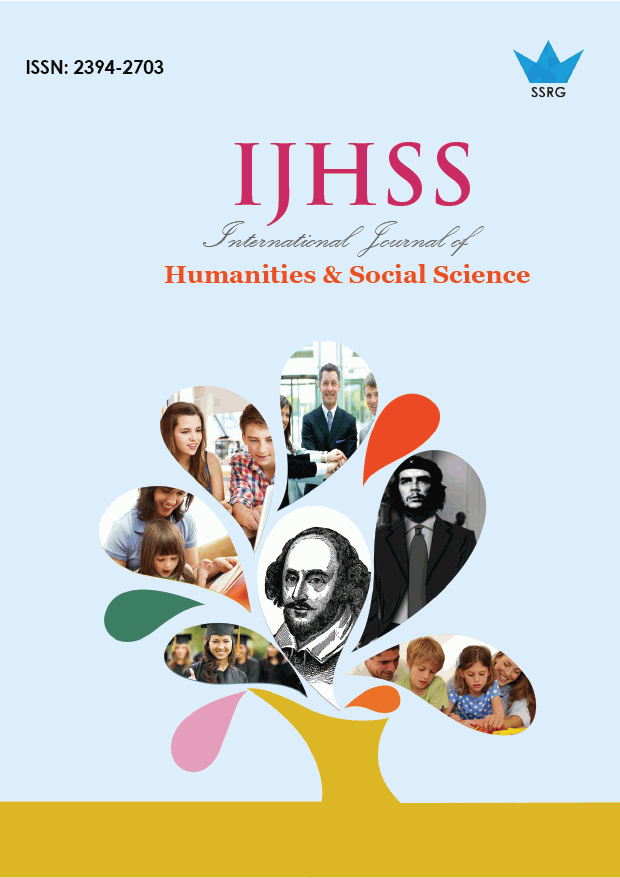Mapping the Perceptions of Bangaloreans towards Flooding and the Influence of Architectural Design on Public Utilities

| International Journal of Humanities and Social Science |
| © 2025 by SSRG - IJHSS Journal |
| Volume 12 Issue 3 |
| Year of Publication : 2025 |
| Authors : Devyani Sehgal |
How to Cite?
Devyani Sehgal, "Mapping the Perceptions of Bangaloreans towards Flooding and the Influence of Architectural Design on Public Utilities," SSRG International Journal of Humanities and Social Science, vol. 12, no. 3, pp. 49-64, 2025. Crossref, https://doi.org/10.14445/23942703/IJHSS-V12I3P108
Abstract:
Despite its global reputation as a planned city and the ‘Silicon Valley’ of India (Kar, 2016: 49), the city of Bangalore has in recent years experienced increasing disruptions caused by rainfall-induced flooding and inadequate urban planning to address this challenge. This research explores the perceptions of Bangaloreans regarding flooding and the role of architectural design in shaping public utilities and infrastructure. Through the use of an online questionnaire, which collected responses through a snowballing process, this paper examines the interpretation of residents for the causes of flooding and their assessment of the performance of public utilities, specifically focusing on waste management, road infrastructure, and water supply. The findings showcase that flooding is mainly a man-made problem, caused by poor drainage systems, inefficient governance and inadequate planning. Further, the findings exhibit widespread disappointment with the public utilities, which are worsened with rapid urbanisation; industrial growth, and the absence of coordination amongst governing bodies. The results portray the need to prioritise sustainable growth, equality and equity, and effective inter-agency collaboration for Bangalore’s sustainable urban growth. Therefore, despite the responses being limited with respect to geographic scope and sample diversity, the key research findings align with the broader literature, hence portraying the need for citizen-centred and resilient urban planning.
Keywords:
Urban flooding, Architectural design, Public utilities, Urban planning, Citizen perception.
References:
[1] Shubha Avinash et al., “Influence of Land Use Changes on Urban Flooding: Case Study of Bangalore City, India,” International Journal of Water Resources Engineering, vol. 5, no. 2, 2019.
[CrossRef] [Google Scholar] [Publisher Link]
[2] Biswaroop Das, “Urban Planning in India,” Social Scientist, vol. 9, no. 12, pp. 53-67, 1981.
[CrossRef] [Google Scholar] [Publisher Link]
[3] Online Desk, Brand Bengaluru: Karnataka Govt Launches Portal Inviting Suggestions on City Development, 2023. [Online]. Available: government.economictimes.indiatimes.com/news/governance/brand-bengaluru-karnataka-govt-launches-portal-inviting-suggestions-on city-development/101167782
[4] Devaraj B. Hirehalli, CM Siddaramaiah’s Focus on Getting Revenue Deficit Grants for 2025-26 Budget, The New Indian Express, 2025. [Online]. Available: www.newindianexpress.com/states/karnataka/2025/Jan/02/cm-siddaramaiahs-focus-on-getting-revenue-deficit grants-for-2025-26-budget
[5] Pearl D’souza, Bengaluru Needs Additional 600 Km Drains to Prevent Flooding, Says Knight Frank Report, The Times of India, 2023. [Online]. Available: timesofindia.indiatimes.com/city/bengaluru/bengaluru-needs-additional-600-km-drains-to-prevent-flooding-says knight-frank-report/articleshow/100650785.cms
[6] Express News Service, Floods Caused Rs 225 Crore Loss: Outer Ring Road Companies Associations, The Indian Express, 2022. [Online]. Available: indianexpress.com/article/cities/bangalore/floods-caused-rs-225-crore-loss-outer-ring-road-companies-associations-8126614
[7] Express News Service, Karnataka Cabinet Approves Rs 694 Crore for BBMP Road Development Project, Green Lights Metro Phase 3A, The Indian Express, 2024. [Online]. Available: indianexpress.com/article/cities/bangalore/karnataka-cabinet-approves-rs-694-crore bbmp-road-development-project-metro-phase-3a-9710789
[8] Anil K. Gupta, and Sreeja S. Nair, “Urban Floods in Bangalore and Chennai: Risk Management Challenges and Lessons for Sustainable Urban Ecology,” Current Science, vol. 100, no. 11, pp. 1638-1645, 2011.
[Google Scholar] [Publisher Link]
[9] Faizan Haidar, India’s Urban Planning Should Shift from a Myopic to a Surplus Mindset: Chairman Emeritus of DLF, The Economic Times, 2024. [Online]. Available: economictimes.indiatimes.com/industry/services/property-/-cstruction/indias-urban-planning-should shift-from-a-myopic-to-a-surplus-mindset-chairman-emeritus-of-dlf/articleshow/115304773.cms?from=mdr
[10] HT News Desk, Water Crisis Likely to Be Back in Bengaluru? Study Finds Decline in Ground Water Level Ahead of Summer, Hindustan Times, 2025. [Online]. Available: www.hindustantimes.com/cities/bengaluru-news/water-crisis-likely-to-be-back-in bengaluru-study-finds-decline-in-ground-water-level-ahead-of-summer 101737881376608.html#:~:text=In%20central%20Bengaluru%2C%20the%20groundwater,as%2020%20to%2025%20meters
[11] Suparna Majumdar Kar, “Locating Bengaluru as India’s Silicon Valley,” Artha – Journal of Social Sciences, vol. 15, no. 2, pp. 49-68, 2016.
[CrossRef] [Google Scholar] [Publisher Link]
[12] Sarah Lee, Empowering Cities through Participatory Urbanism. [Online]. Available: www.numberanalytics.com/blog/participatory-urbanism-ultimate guide#:~:text=Participatory%20urbanism%20is%20an%20approach,and%20aspirations%20of%20the%20community
[13] T.V. Ramachandra, and N. Ahalya, Conservation and Management of Wetland Ecosystems in Karnataka, Centre for Ecological Sciences, Indian Institute of Science, 2000.
[Google Scholar] [Publisher Link]
[14] L. Sudershan Reddy, and Kannamani Ramasamy, The Significant Challenges in Bangalore – An Introspection, Adalya Journal, vol. 9, no. 4, pp. 228-247, 2020.
[CrossRef] [Google Scholar]
[15] Jeffrey Raven, 5 - Urban Planning and Urban Design, Cambridge University Press, 1st ed., pp. 139-172, 2018.
[CrossRef] [Google Scholar] [Publisher Link]
[16] Sudeept Maiti, and Joao Villela De Faria, “Participatory Planning Processes in Indian Cities: Its Challenges and Opportunities,” Journal of Sustainable Urbanization, Planning and Progress, vol. 2, no. 1, pp. 1-17, 2017.
[CrossRef] [Google Scholar] [Publisher Link]
[17] Pallavi Mukhopadhyay, and Bijay Kumar Das, “Urban Flooding: Case Study of Bangalore,” Journal of Environmental Impact and Management Policy, vol. 3, no. 5, 2023.
[CrossRef] [Google Scholar] [Publisher Link]
[18] Janaki Nair, Bengaluru Development Needs Better Planning, Hindustan Times, 2024. [Online]. Available: www.hindustantimes.com/opinion/bengaluru-development-needs-better-planning-101726070984145.html
[19] N.N. Rama Prasad, and Priya Narayanan, “Vulnerability Assessment of Flood-affected Locations of Bangalore by Using Multi-criteria Evaluation,” Annals of GIS, vol. 22, no. 2, pp. 151-162, 2016.
[CrossRef] [Google Scholar] [Publisher Link]
[20] Surendra Puttalingaiah, Ashok D. Hanjagi, and Shahnin Irfan, “Levels of Urbanization in Bangalore Urban District of Karnataka, India,” European Proceedings of Social and Behavioural Sciences, vol. 95, 2020.
[CrossRef] [Google Scholar] [Publisher Link]
[21] Marisa Sailus, 7 Types of Urban Planning Concepts Explained, Strategy Planning & Execution Blog, 2025. [Online]. Available: www.clearpointstrategy.com/blog/types-of-urban-planning
[22] G.S. Sastry, “Emerging Development Issues of Greater Bangalore,” Working Paper No. 194. Institute for Social and Economic Change, 2008.
[Google Scholar] [Publisher Link]
[23] G.S. Sastry, “Urbanization in an IT Prominent State of India: Patterns, Issues and Policy ‘in Sustainable Development and the Indian Economy: Issues and Challenges,” Serials Publications, New Delhi, 2006.
[Google Scholar]
[24] Preeti Tewari et al., “Increasing Frequency of Urban Floods: Lessons from Bengaluru Floods,” Disaster and Development: Journal of the National Institute of Disaster Management, vol. 12, no. 01, pp. 47-59, 2020.
[Google Scholar]
[25] T.G. Uma, and Mallikarjun Chanmal, “An Empirical Study of Urban Infrastructure in Bengaluru,” International Journal of Applied Research, vol. 2, no. 7, pp. 559-562, 2016.
[Publisher Link]

 10.14445/23942703/IJHSS-V12I3P108
10.14445/23942703/IJHSS-V12I3P108